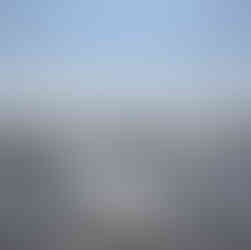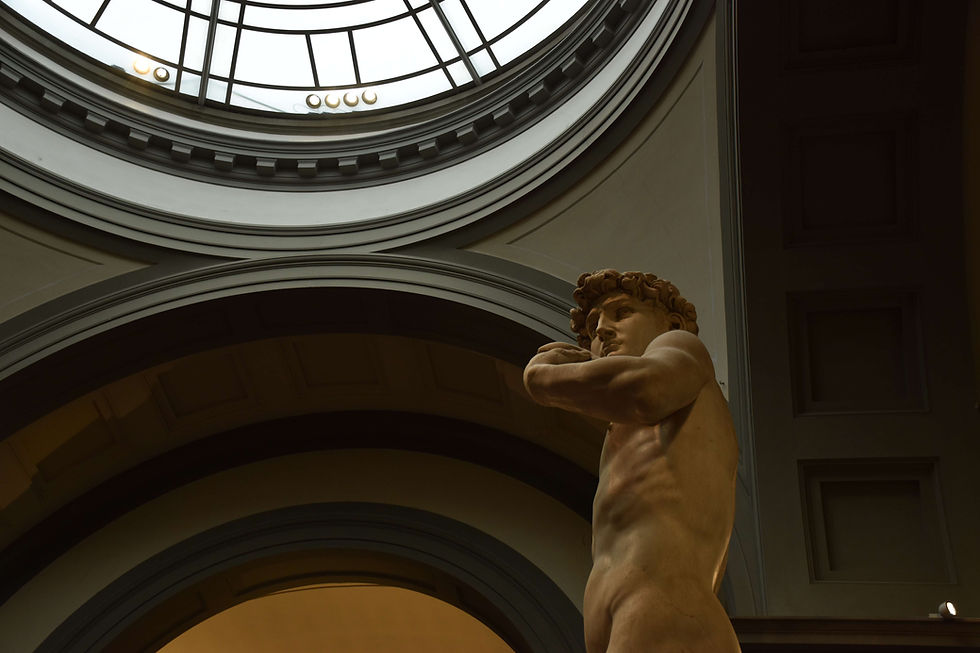Mont-Saint-Michel
- Autumn Mayer
- Mar 5
- 6 min read
Continuing from my last blog post about Paris, I arrived in Villedieu-les-Poêles and boarded a bus to Mont-Saint-Michel. Then there was a shuttle to the end of the passerelle (the bridge to the island). As other visitors snapped pictures from the passerelle, I entered the medieval city through the main archway in the outer wall. Just inside the walls, I got a sandwich at an outdoor café. (It seems the pre-made, rewarmed paninis that certain tourist-focused eateries have are standardized across the country; the Louvre and the cafeteria at my university have the same items.) My hotel was up a staircase not far up the road. I was too early to check in, so I dropped off my bag behind the desk and went back to the passerelle to take some pictures. Then I worked my way up to the Abbeye at the top of the Mont, passing gift shops and restaurants along the way.
At the Abbeye, I entered with my pre-timed ticket, free for students residing in the EU. The Mont-Saint-Michel was originally called Mont Tombe and has always been a place connected with venerating and praying for the deceased. In 708, the archangel Michael appeared to St. Aubert, the bishop of Avranches, in a vision to ask him to build a sanctuary on the Mont. St. Michael's patronage continued the tradition in connection with the dead, as the 'psychopomp' archangel is known for weighing the souls of the dead and guiding them to heaven. In the 10th century, the Duke of Normandy established a community of Benedictine monks on the Mont, and they built the first church in 966. The village began to develop. In the 11th century, four crypts and the abbey church were constructed. After the conquest of Normandy, a donation from King Phillippe Auguste of France permitted further additions, including the monks' refectory and cloister. The ramparts and fortifications were added next and allowed Mont-Saint-Michel to withstand a 30-year siege by the English during the Hundred Years' War, establishing the Mont as a symbolic place of French identity and strength. The Romanesque choir was destroyed and replaced by the current Flamboyant Gothic choir. During the French Revolution, the Mont became the Bastille of the Seas, housing 14,000 prisoners until 1863. The tides and quicksand acted as natural, dangerous barriers to escape. The prison was eventually closed at least in part at the request of romantic writers and artists. For a period, the Mont fell into disrepair. It was restored by the Service des Monuments Historiques. A road dyke was constructed in 1879, alongside new buildings in the Norman and Gothic revival styles. The gold-gilded statue of St. Michael on the bell tower was added in 1897. Between 1928 and 1938, the architectural pastiches were destroyed to restore the village's medieval appearance. During WWII, Mont-Saint-Michel was occupied by the Germans but not destroyed. In 1966, the religious community returned; they've been the Monastic Fraternities of Jerusalem since 2001. A dam was built in 1969 in order to preserve the Mont's island nature, as human developments had lessened the ability of the river Couesnon and the tides to wash sediments out to sea, which in turn prevented the tides from turning the Mont into an island each day. Mont-Saint-Michel was added to the list of UNESCO World Heritage Sites in 1979. Today, five monks and seven nuns live there.

As I entered the Abbeye, I was stunned by its simple, breathtaking beauty. You enter through the guardroom, installed during the Hundred Year's War; this fortified entrance was once where pilgrims were greeted. The Grand Degré staircase leads to the Saut-Gaultier terrace, then the West Terrace, which offers a view from some 80 meters above sea level. Seagulls perched on the ramparts, unbothered by the tourists. The tide was going out, and the bright sun cast reflections on the still-wet sand, making it scintillate like ice. I lingered outside with the view for a while before turning inside to the abbey church, where I was stunned once more. The vaulted ceilings were hardly decorated in comparison to churches like the Madeleine that I had seen the day before. But there was something poignant about this bare, weathered old stone and the silence it held within itself that made it so much more attractive than the gilded glory of those other churches. It had just been this place, the sea, its small religious community, and God for centuries.
The visit continued to the cloister. Symmetrical rows of pillars lined a vibrant, spring-green courtyard of grass. This was probably my favorite part of the Abbeye. Next was the monks' refectory; the Salle des Hôtes, used to host visiting kings and nobles; the Crypt of the Great pillars that supports the choir of the abbey church; St. Martin's Crypt; the Wheel Room, which houses a huge wheel used to bring food up to the inmates during the prison period; the Saint-Étienne chapel; the north-south staircase; the monks' promenoir; the scriptorium; the chaplaincy, used to receive pilgrims and the poor; and the cellar, which now holds the gift shop. The visit ended once again on the ramparts with a view of the bay. After the Abbeye, I wandered through the town, discovering little alleys and back staircases that connected the private parts of the island. There are about 20 residents (plus cats!). I paid the €12 student fare to visit the museums, which were unfortunately a bit outdated and not terribly interesting.
By 3:45, I checked into my hotel. My room was amazing, with a large bed and a bathtub the size of the entire bathroom in the Paris hostel. When I looked on Google Maps for restaurant hours, I noticed many of the places that sounded promising--not takeaway crêpes/sandwiches or overly pricey sit-down places--closed around 5:00 or 6:00 because it wasn't the primary summer season. The restaurant I ended up at turned out to close at 9:00, so I felt a little silly ordering a full salmon dinner at 4:45 when everyone around me was enjoying crêpes as an afternoon snack. At least the wait wasn't long! A little before sunset, I took my camera back to the passerelle to watch the sun set. On the way back inside, I checked out another entrance/side door, which deposited me on the peaceful beach on the other side of the Mont. Then I turned in for the night.

The next morning, I finally, finally had a chance to sleep in. I got breakfast at the hotel and checked out of my room. At the entrance/exit, I was surprised to find water lapping through the archway. Luckily, it wasn't yet full high tide, and I was able to reach the passerelle through the side door I had discovered the night before. The walk back across the passerelle revealed new views of the Mont, reflected perfectly in the water of the bay. There were also sheep in the pastures. There's a regional delicacy, I overhead from a British tourist on the shuttle, called pre-salted lamb; the sheep feed on the salty grasses that grow beside the bay. I briefly explored the dam that helps Mont-Saint-Michel maintain its island nature.
I took the shuttle the little ways back to the parking lot and tried to call an Uber. The pick up spot was where I had just been, near the end of the passerelle, so I started walking back. I waited for my ride to be confirmed, but it just kept loading and loading. Then I got a notification that no drivers were available in the area. Luckily, there ended up being a bus that went to Pontorson, the nearby town where I'd be boarding my train. In Pontorson, I waited an hour and a half for my train. I'd left super early because I hadn't been confident in my transportation method to Pontorson, and I was glad for my caution. I had a layover in Rennes, a mid-sized city in Bretagne. I got a crêpe (crème de marron, of course) for a late lunch. Then, wanting to be able to say I'd visited Bretagne, I walked around the block near the station and bought a postcard. I read my book back at the station, bought a sandwich for an early dinner, and hopped on my train back to Lyon. I got lucky with the timing of the transportation in Lyon, only having to wait a couple minutes for both the tram and the bus. I made it back to my homestay around 10:15, exhausted and satisfied from my trip.
.jpg)





















Comments